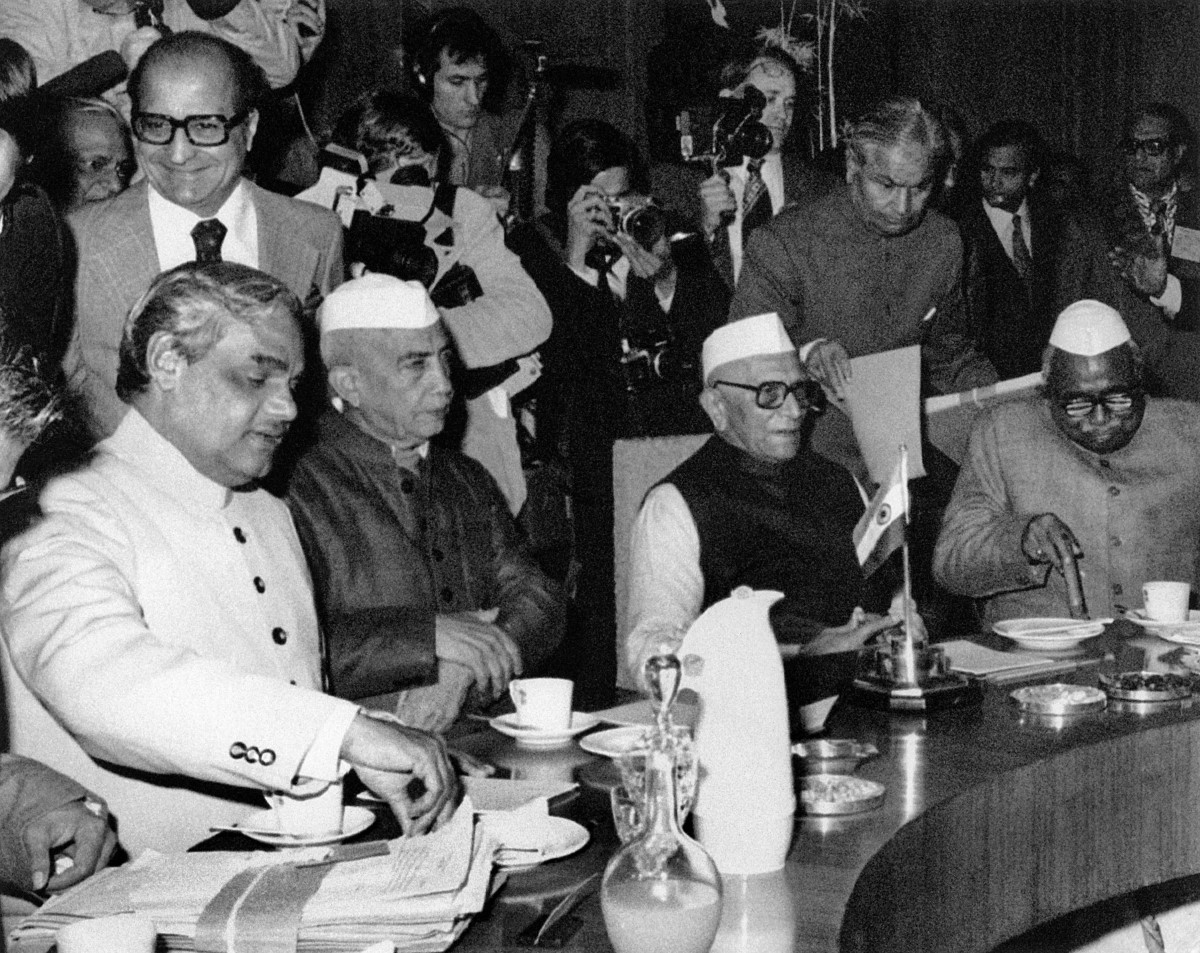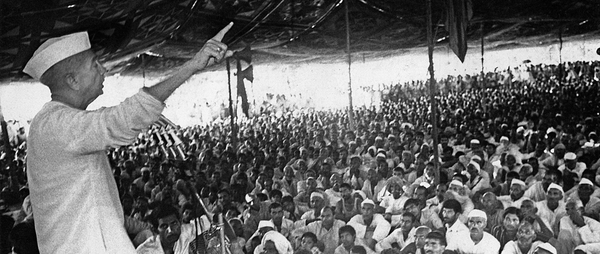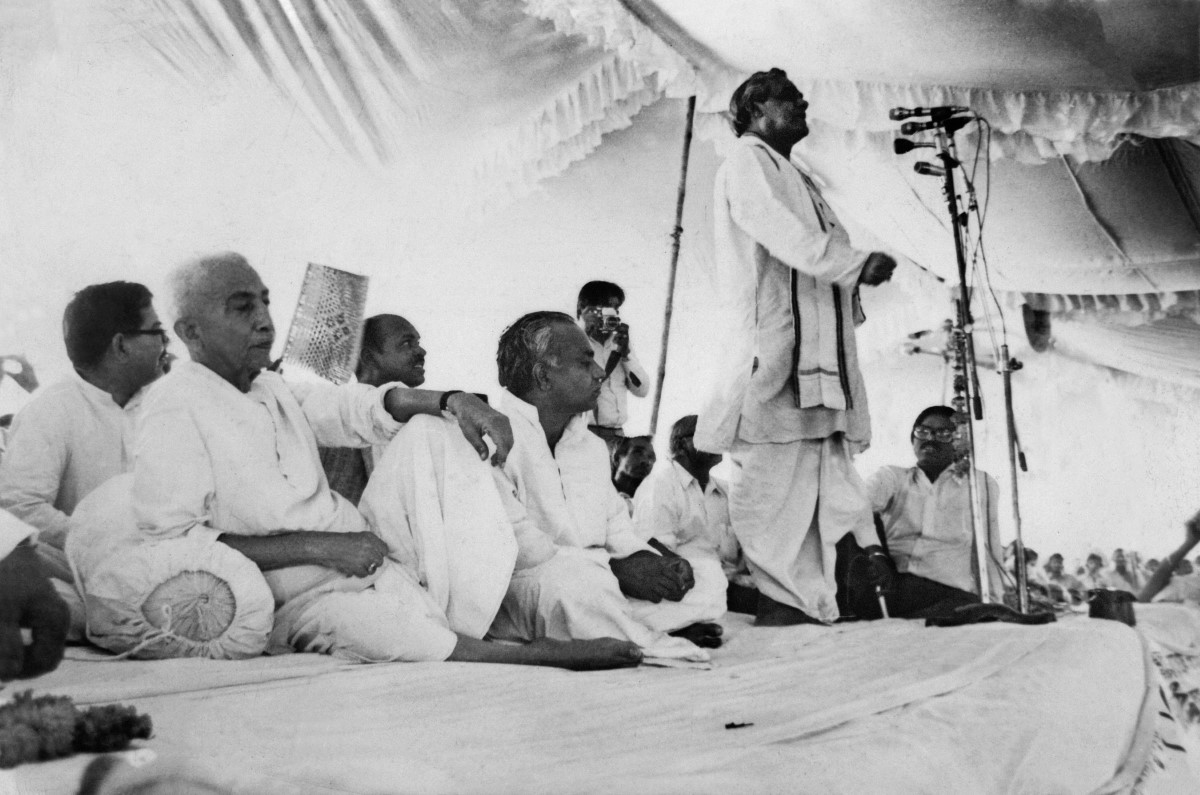Introduction
Charan Singh was working on a manuscript The Rise and Fall of the Janata Party [1] during 1984-85 to present his perspective on the political events that led to the formation of the Janata Party, and the formation of the first non-Congress government in India at the Centre between 1977 and 1979. Singh suffered a brain stroke in November 1985 from which he never recovered and soon passed away in May 1987. Nonetheless, this work contains sufficient food for thought for political historians, including blow-by-blow accounts of Charan Singh’s untiring efforts to bring about political unity in parties that were in opposition to Indira Gandhi’s Congress.
Singh starts the book in his inimitable direct style:
“Amongst the many myths, half lies and outright lies that have been written and spoken about the Janata Party’s tragedy, perhaps the central one is about who formed this party and who broke it. I wish to deal with this in some detail because all the forces that have worked overtime and single-mindedly to slander me have succeeded in creating the myth that it was Jayaprakash Narayan who built the Janata Party and it was I who broke it. While I will come to the latter part of this myth later, let me describe how the Janata Party came into being. In the process, I shall also describe the roles of those who later captured the party for their own ends.” [2]
Background: Political Landscape in 1975
Indira Gandhi lost the case brought against her by Raj Narain concerning allegations of electoral malpractice, which had been pending before the Allahabad High Court in 1975. Four major political parties in opposition to the Congress of Mrs. Gandhi - Congress(O), Bharatiya Lok Dal, Jana Sangh, and the Socialist Party (constituents of what later came to be called the Janata Party) - were developing a strategy for a united political campaign to unseat Indira Gandhi in the wake of the Allahabad High Court’s judgment. A meeting of opposition leaders of these parties on June 17/18, 1975 advocated for the initiation of a mass movement aimed at securing Gandhi’s removal from the position of Prime Minister. Singh remarked, “I recall once again advocating for the formation of a unified opposition party. Regrettably, even at this advanced stage, this proposal did not receive support from the leaders.” [3] In response, Prime Minister Indira Gandhi declared a national emergency for reasons most political commentators and civil society found dubious and constitutionally corrupt, arresting prominent opposition leaders as well as tens of thousands of political workers.

1978-01-02 Prime Minister Morarji Desai flanked by Jagjivan Ram, Ch Charan Singh and Atal B Vajpayee meeting President of United States of America Jimmy Carter in Delhi
The Formation of the Janata Party
An early meeting of some leaders of the political opposition, arrested under the draconian Maintenance of Internal Security Act (MISA), took place in Ward No 2 of Tihar jail in Delhi on 4 January 1976. Political heavyweights including Chaudhary Charan Singh of the BLD, Parkash Singh Badal of the Akali Dal, Nanaji Deshmukh of the Jana Sangh and Surendra Mohan of the Socialist Party, met to discuss the merger of their respective political parties into one unified whole. While Charan Singh pushed for a complete merger and dissolution of the individual identities of each party, others desired a federal unity. Later in 1976, Jayaprakash Narayan convened a meeting of major leaders of these political parties in Bombay and asked them to draft a programme for a unified opposition party.
In an undated note [4], Charan Singh recounted that the BLD had requested the leaders of the three major opposition parties as early as 1974 and 1975 to join hands in forging a united political organisation. Had the other parties not rejected the idea then, Singh believed that country might as well have been spared the excesses and horrors of the Emergency. The Jana Sangh and the Socialist Party came around only after all their leaders were imprisoned and the Congress (O) agreed only after its leader Morarji Desai was released and saw ‘immediate prospects of power’ in doing so [5] .
Key Events
In a letter dated April 9 1976 to N.G. Goray, convenor of the steering committee set up during JP’s meeting, BLD’s Acting General Secretary Bhanu Pratap Singh had clearly defined his party’s position that ‘the name, flag and symbol of the New Party be different from the existing ones of any opposition party’ and that on joining the New Party all parties will be dissolved and suggested that the name be ‘Janata Party’ and the symbol be of a farmer with a pair of bullocks. Charan Singh believed that the existing parties should be dissolved before the new one is launched and not after. He held that it was only a single united front under one flag, one symbol and one manifesto with a clearly defined ideology as an alternative to the Congress that could win people’s faith. Any other mechanism would only complicate the situation further.
In a meeting that took place in New Delhi on July 8, Charan Singh also firmly demanded that no RSS volunteers can join the New Party as dual membership could not be allowed. Prominent political commentator AG Noorani [6] also takes a note of the apologetic ‘letters in sycophancy’ written to Mrs Gandhi by RSS Chief Balasaheb Deoras, and the approach paper by Biju Patnaik (that he had falsely claimed to have the support of the Opposition leaders) listing the ‘gains of the Emergency’ applauding Indira Gandhi’s 20 Point programme.
Since Singh would not accept anything less than a merger he did not agree to the other three parties’ proposal of the joint functioning of the four parties as part of the unification process. By September, while Jana Sangh and the Socialists had agreed to the merger, Congress (O), especially its Tamil Nadu, West Bengal and Gujarat units, were not in its favour. Asoka Mehta of the Congress (O), again, raised the question of Presidentship and wanted to await the presence of Morarji Desai. In his unfinished manuscript, Singh notes that he was most disappointed with the attitude of the Congress(O) and its leaders for several reasons. He recalled that once when him and some other leaders went to Mr Desai to discuss their merger into a new party, Desai’s ‘only reaction was that if they merged into a new party, what would happen to their office building which was than an object of judicial dispute between the Congress (O) and the Congress (I)’ [7] . Apart from such petty concerns, Congress (O) leaders were also unwilling to dissolve their party and merge into a new united party despite others’ efforts to unify the opposition. The party’s leadership was resistant to changing their identity, preferring to maintain their separate existence rather than forming a single, strong opposition party.
The process of bringing together various parties and leaders was complex and cumbersome, with clashes of egos and personalities, divisions in the ranks, and honest difference of opinions, but it eventually came to fruition.
Mrs. Gandhi announced her decision to hold elections to the Lok Sabha on January 18, 1977. Five days later, the Janata Party came to be formally established despite the earlier hiccups – this shotgun wedding did not bode well for a unified and stable political party. Mrs. Gandhi responded to Opposition unity with a slew of allegations, ranging from communalism to foreign support and their desire for violence.
Charan Singh as an Architect of Political Alliances
While Charan Singh's role in uniting disparate parties for the formation of the Janata Party is relatively well-documented, his involvement in consolidating various coalitions began in the 1960s, a period marked by intensifying conflicts within the Uttar Pradesh Congress [8] . Charan Singh played a pivotal role in establishing and helping consolidate coalition politics in India from 1967 till 1985. As Chief Minister, he led the Samyukta Vidhayak Dal comprising the Jana Sangh, Samyukt Socialist Party, Communists, Swatantra Party, Praja Socialist Party (PSP), and Independents in UP from April 1967 to February 1968. The Bharatiya Kranti Dal (BKD) was created by senior ex-Congressmen in 1967 after leaving the Congress Party, including Charan Singh. The BKD emerged as an alternative to the Congress Party in several States, particularly in Uttar Pradesh [9].
Singh’s disillusionment with the internal discord within the SVD prompted a reevaluation of his approach to political coalitions. He began to conceptualize the formation of a unified party that would oppose both the Congress and the Communists. To this end, he engaged in discussions with the Swatantra Party, the PSP, the Jana Sangh, and other political entities. This objective was a central focus in numerous meetings of the BKD's national executive. Members of the Jana Sangh accused Singh of pursuing personal ambitions through these efforts; however, Singh expressed his disappointment with such allegations in his correspondence with party leaders. In a letter dated June 12, 1969, addressed to N.G. Ranga, Singh reiterated his commitment to establishing a strong democratic party prioritizing national interests above personal gains. He criticized the Jana Sangh for its failure to transcend narrow, immediate concerns and for not taking the necessary steps to build a "formidable political machine" to “hold the country together”. Singh’s discussions with the PSP, the Lok Tantrik Dal in Bihar, Janta Raksha of Mysore, and the Jana Congress of Orissa over several months underscore the breadth of his ambition for coalition building and his national vision. Singh's intent was clearly not to confine his efforts to only North India.
In September 1969, despite previous disappointments, Singh considered reuniting the SVD, recognizing its potential importance in countering the Congress's perceived partisan and undemocratic practices, including the suppression of political opposition, increasing inefficiency, corruption, and nepotism (as noted in a confidential memorandum circulated in September 1969). These events mark significant moments in the history of coalition politics. Following the deterioration of the Congress (R) alliance in August 1970, Singh successfully garnered support from the Jana Sangh, Congress (O), and the Swatantra Party. However, a planned floor test was obstructed by the governor in favor of imposing President's rule. Interestingly, following his resignation earlier in February 1969, Singh had chosen not to form alliances with the Jana Sangh and the Swatantra Party, citing his previous negative experiences with these parties during his efforts to establish a unified political entity. However, the evolving political circumstances involving Indira Gandhi led to a swift change in this stance.
In March 1974, a significant political alliance emerged under the leadership of Charan Singh, comprising the BKD, Swatantra Party, and Muslim Majlis. This tripartite coalition was primarily formed to counteract what was perceived as the increasing consolidation of power by Indira Gandhi. Notably, the Jana Sangh expressed strong reservations about collaborating with a Muslim-centric party. In contrast to the Jana Sangh's position, Charan Singh demonstrated a more pragmatic approach to coalition-building. Despite being often characterized as "communal" by the contemporary press, Singh exhibited no hesitation in forging an alliance with a party that the Jana Sangh found particularly objectionable (Brass, 2014). This willingness to transcend ideological boundaries in pursuit of broader political objectives underscores Singh's strategic acumen and his prioritization of immediate political goals over rigid ideological considerations. These developments suggest that the Janata Party experiment may be seen as the culmination of Singh’s long-term coalition-building efforts.
In the aftermath of the 1974 UP Assembly election and the large-scale rigging by the Congress Party using government machinery, the BKD decided to take the lead in bringing all the Democratic opposition parties in the country under one flag in its quest to preserve democracy. He noted,
“The process of trying to bring together various parties and leaders was as tortuous then as it was in recent years; the same clashes of egos and personalities, the similar Congress agents within the Opposition ranks constantly working to keep everyone divided, and the same petty intrigues of the so-called important Opposition leaders” [10] .
Despite the larger parties giving short shrift to Charan Singh’s idea of a single party, a breakthrough pushing such unification took place in April 1974 when eight of the smaller political parties - Bharatiya Kranti Dal, Samyukt Socialist Party, Swatantra Party, Utkal Congress, Khetihari Sangh, Harijan Sangharsh Samiti, Loktantrik Dal, and Muslin Majlis - agreed to merge into a new party, the Bharatiya Lok Dal, under Charan Singh’s leadership.
Singh’s Samyukta Vidhayak Dal government in UP in 1967, the birth of the BLD in 1974, and the 1976-80 Janata Party experiment went on to become the basis of the first National Democratic Alliance (NDA) coalition that was established in 1983 under Charan Singh’s and Atal Bihari Vajpayee’s leadership. Singh’s was a historical role in the maturing of India’s electoral democracy: starting with a single party with multiple political factions (Congress), the SVD (a coalition of disparate political ideologies and cadre), the BLD in which a smaller political parties came together in 1974, the Janata Party in 1977 which was a unified party but was driven with factional dissension and jockeying for power, then his continued attempts at Opposition unity leading to the formation of the first NDA in 1983 with Vajpayee. Presiding over the inaugural meeting of the National Democratic Alliance on August 17, 1983, Charan Singh announced the decision of the Lok Dal and BJP to forge an alliance to strengthen democracy [11] . Charan Singh was named the Chairman of the Coordination Committee of the NDA and its leader in the Lok Sabha and A.B. Vajpyaee was to be the Chairman of the NDA in the Parliament [12] . After prolonged deliberations that had lasted for months, it was decided that there must be harmony in the programme and approach of the two parties, especially drawing from socio-economic transformation on Gandhian lines. While Singh's approach to political alliances demonstrated pragmatic flexibility, he nevertheless maintained a consistent and unyielding vision for policy and values. He established alliances both within and outside of the Congress Party, consistently adhering to a principled framework for Indian development informed by his economic theories.
This framework is encapsulated in the different manifestos of his various parties as well as his 1977 publication, India’s Economic Policy: Gandhian Blueprint. Additionally, Singh's steadfast adherence to his standards of political ethics is notable. He held the conviction that the country's salvation lay in following the path delineated by Gandhi [13] .
Through all this, Charan Singh provided the nation (and his political coalition partners) a sophisticated model that opposed the Congress and it’s pro-urban, upper caste-led elite policies, its neglect of OBCs, the village economy and agriculture.
The maturation of coalition politics since the 1990s can certainly be attributed to his pioneering efforts in coalition building for a political cause.
Sources and References
.[1] The typed script of the unpublished book by Chaudhary Charan Singh accessed in File 1 of the third section of III Instalment of Chaudhary Charan Singh files at PMML. Singh was working on the manuscript in 1984-85.
.[2] Ibid
.[3] Ibid
.[4] An undated note by Chaudhary Charan Singh accessed in File 163 of II Instalment of Chaudhary Charan Singh files at PMML https://charansingh.org/political-timeline/undated-note-political-setting-1970s-and-80s
.[5] Ibid https://charansingh.org/political-timeline/undated-note-political-setting-1970s-and-80s
.[6] Article titled ‘Janata - the way it was born’ by A.G. Noorani published in The Illustrated Weekly of India on November 26, 1978, accessed in File 172, II Instalment of Chaudhary Charan Singh files at PMML https://charansingh.org/political-timeline/janata-way-it-was-born-ag-nooranii
.[7] The typed script of the unpublished book by Chaudhary Charan Singh accessed in File 1 of the third section of III Instalment of Chaudhary Charan Singh files at PMML
.[8] To know more about coalition politics in UP in the 1960s, check Brass, Paul R. (1968). “Coalition Politics in North India”. The American Political Science Review, Vol. 62, No. 4 (Dec 1968), pp. 1174-1191. https://charansingh.org/archives/coalition-politics-north-india
.[9] Ibid https://charansingh.org/archives/coalition-politics-north-india
.[10] Ibid https://charansingh.org/archives/coalition-politics-north-india
.[11] Press Note accessed in File 207, II Instalment of Chaudhary Charan Singh papers at PMML https://charansingh.org/political-timeline/nda-bjp-and-lok-dal
.[12] Ibid https://charansingh.org/political-timeline/nda-bjp-and-lok-dal
.[13] Bharatiya Kranti Dal Manifesto of 1968





